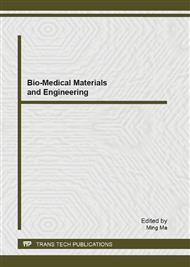p.384
p.388
p.394
p.401
p.408
p.413
p.418
p.423
p.429
Effects of Porcine Collagen Peptides on Biological Behavior of PC12 Cells
Abstract:
The present study was designed to investigate the effects of porcine collagen peptides on biological behavior of PC12 cells, the Amino acid composition of porcine collagen peptides was analyzed using Amino Acid Analyzer, the contact angles were measured with a goniometer, and after treatment with porcine collagen peptides, the impact of peptides on cells proliferation and differentiation was evaluated using MTT assay and Real-time PCR respectively. porcine collagen peptides is found to contain mainly Gly, Pro and Hyp, the contact angles of porcine collagen peptides surfaces were approximately 23.3°. MTT Results revealed that collagen peptides promoted PC12 cells proliferation at the given concentrations with its maximum effect at the concentration of 0.2 mg/ml (P<0.01), Real-time PCR Results revealed the poricine collagen peptides had no influence on the expression of specific neuronal marker β3-tubulin. Results of this study suggest that based on their bioactivity, porcine collagen peptides could be promising candidates for biomaterials.
Info:
Periodical:
Pages:
408-412
Citation:
Online since:
August 2013
Keywords:
Price:
Сopyright:
© 2013 Trans Tech Publications Ltd. All Rights Reserved
Share:
Citation:


